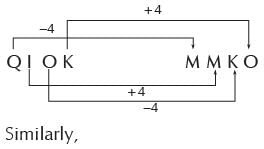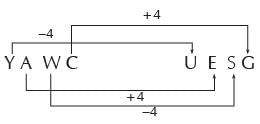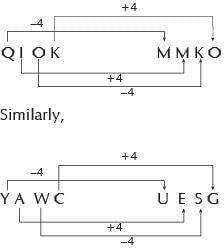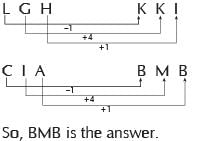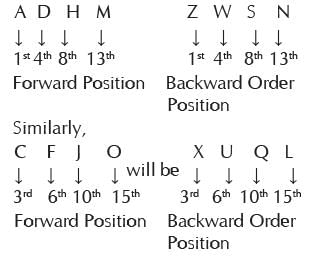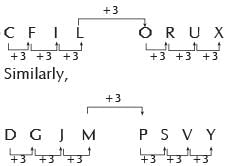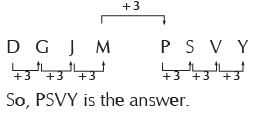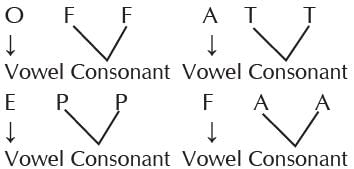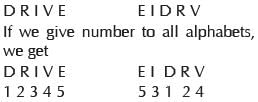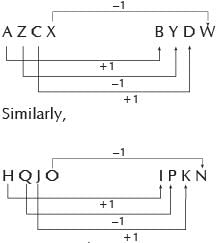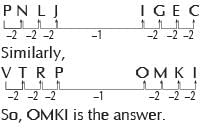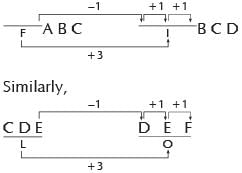All Exams >
Class 5 >
Science Olympiad for Class 5 >
All Questions
All questions of Analogy and Classification for Class 5 Exam
‘Hindi’ is related to ‘Utter Pradesh’, inthe same way as ‘Oriya’ is related to- a)West Bengal
- b)Andhra Pradesh
- c)Odisha
- d)Haryana
Correct answer is option 'C'. Can you explain this answer?
‘Hindi’ is related to ‘Utter Pradesh’, inthe same way as ‘Oriya’ is related to
a)
West Bengal
b)
Andhra Pradesh
c)
Odisha
d)
Haryana
|
|
Harshad Goyal answered |
Hindi is the main spoken language of U.P. and Oriya is the main spoken language of Odisha.
Writer: Pen :: ?- a)Needle : Tailor
- b)Artist : Brush
- c)Painter : Canvas
- d)Teacher : Class
Correct answer is option 'A'. Can you explain this answer?
Writer: Pen :: ?
a)
Needle : Tailor
b)
Artist : Brush
c)
Painter : Canvas
d)
Teacher : Class
|
|
Arjun Yadav answered |
Writer uses ‘Pen’ to write. Similarly Tailor uses needle to sew.
‘Disease’ is related to ‘Medicine’, inthe same way as Famine is related to- a)Drought
- b)Waterfall
- c)Rainfall
- d)Clouds
Correct answer is option 'C'. Can you explain this answer?
‘Disease’ is related to ‘Medicine’, inthe same way as Famine is related to
a)
Drought
b)
Waterfall
c)
Rainfall
d)
Clouds
|
|
Aniket Mukherjee answered |
Disease is cured by Medicine. In
the same way Famine is controlled
by Rainfall.
the same way Famine is controlled
by Rainfall.
Select the related word/ number from the given alternatives.PNLJ : IGEC :: VTRP : ?- a)OMKI
- b)RSTU
- c)QSRC
- d)RPOM
Correct answer is option 'A'. Can you explain this answer?
Select the related word/ number from the given alternatives.
PNLJ : IGEC :: VTRP : ?
a)
OMKI
b)
RSTU
c)
QSRC
d)
RPOM
|
|
Abhay Datta answered |
Expression = PNLJ : IGEC
The pattern followed is :
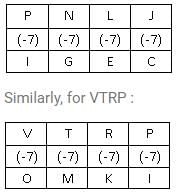
Select the related word/ number from the given alternatives.BEHK : YVSP : : DGJM : ?- a)JGDA
- b)ROLI
- c)WTQN
- d)ZWTQ
Correct answer is option 'C'. Can you explain this answer?
Select the related word/ number from the given alternatives.
BEHK : YVSP : : DGJM : ?
a)
JGDA
b)
ROLI
c)
WTQN
d)
ZWTQ
|
|
Kiran Das answered |
In this question, Right hand side alphabets have corresponding position in reverse order.
Chisel : Sculptor :: Harrow : ?- a)Gardener
- b)Mason
- c)Blacksmith
- d)Guard
Correct answer is option 'A'. Can you explain this answer?
Chisel : Sculptor :: Harrow : ?
a)
Gardener
b)
Mason
c)
Blacksmith
d)
Guard
|
|
Keerthana Menon answered |
A sculptor is a person who uses chisel to make sculptures, similarly, a gardener uses harrow to plough field.
Select the related word/ number from the given alternatives.ABE : 8 :: KLO : ?- a)37
- b)39
- c)38
- d)36
Correct answer is option 'C'. Can you explain this answer?
Select the related word/ number from the given alternatives.
ABE : 8 :: KLO : ?
a)
37
b)
39
c)
38
d)
36
|
|
Ashish Malik answered |
Pattern:
In the given question, there is a certain pattern between the letters and the corresponding numbers. Let's try to understand this pattern.
Explanation:
- The first letter in the given pair is 'A' and its corresponding number is 8.
- The second letter in the given pair is 'B' and its corresponding number is 5.
- The third letter in the given pair is 'E' and its corresponding number is 2.
Pattern:
- If we observe closely, we can see that the numbers are the positions of the letters in the English alphabet.
- For example, 'A' is the first letter, so its corresponding number is 1.
- 'B' is the second letter, so its corresponding number is 2.
- Similarly, 'E' is the fifth letter, so its corresponding number is 5.
Applying the Pattern:
Now, let's apply this pattern to the given pair 'KLO' and find its corresponding number.
- The first letter in the given pair is 'K' and its corresponding number is 11.
- The second letter in the given pair is 'L' and its corresponding number is 12.
- The third letter in the given pair is 'O' and its corresponding number is 15.
Therefore, the corresponding number for the pair 'KLO' is 11, 12, 15.
Answer:
The related number for the given pair 'KLO' is 11, 12, 15. None of the given options match this pattern except option C, which is 38. So, the correct answer is option C, 38.
In the given question, there is a certain pattern between the letters and the corresponding numbers. Let's try to understand this pattern.
Explanation:
- The first letter in the given pair is 'A' and its corresponding number is 8.
- The second letter in the given pair is 'B' and its corresponding number is 5.
- The third letter in the given pair is 'E' and its corresponding number is 2.
Pattern:
- If we observe closely, we can see that the numbers are the positions of the letters in the English alphabet.
- For example, 'A' is the first letter, so its corresponding number is 1.
- 'B' is the second letter, so its corresponding number is 2.
- Similarly, 'E' is the fifth letter, so its corresponding number is 5.
Applying the Pattern:
Now, let's apply this pattern to the given pair 'KLO' and find its corresponding number.
- The first letter in the given pair is 'K' and its corresponding number is 11.
- The second letter in the given pair is 'L' and its corresponding number is 12.
- The third letter in the given pair is 'O' and its corresponding number is 15.
Therefore, the corresponding number for the pair 'KLO' is 11, 12, 15.
Answer:
The related number for the given pair 'KLO' is 11, 12, 15. None of the given options match this pattern except option C, which is 38. So, the correct answer is option C, 38.
Direction: Select the related word/ number from the given alternatives.
BEHK : YVSP : : DGJM : ? - a)JGDA
- b)ROLI
- c)WTQN
- d)ZWTQ
Correct answer is option 'C'. Can you explain this answer?
Direction: Select the related word/ number from the given alternatives.
BEHK : YVSP : : DGJM : ?
BEHK : YVSP : : DGJM : ?
a)
JGDA
b)
ROLI
c)
WTQN
d)
ZWTQ
|
|
Sagnik Saha answered |
In this question, Right hand side alphabets have corresponding position in reverse order.
Three of the following four are alike in a certain way so form a group select the one which does not belong to the group.- a)BADC
- b)XWZY
- c)VUST
- d)NMPO
Correct answer is option 'C'. Can you explain this answer?
Three of the following four are alike in a certain way so form a group select the one which does not belong to the group.
a)
BADC
b)
XWZY
c)
VUST
d)
NMPO
|
|
Subhankar Kulkarni answered |
Understanding the Groups
To determine which option does not belong to the group, we need to analyze the patterns in the sequences provided.
Analyzing the Options
- a) BADC
- This sequence involves letters that have been reversed from their original order.
- The original order would be ABCD, and BADC is formed by switching the positions of A and B, and C and D.
- b) XWZY
- Similar to option A, this sequence also has letters reversed from their original order.
- The original order is WXYZ, and XWZY is formed by switching the positions of W and X, and Y and Z.
- c) VUST
- This sequence does not follow the same pattern.
- The letters are not merely reversed; they appear to be in a random order without a clear method of switching.
- d) NMPO
- This sequence also involves a reversal of letters.
- The original order would be MNOP, and NMPO is formed by switching the positions of N and M, and O and P.
Conclusion
The sequences a) BADC, b) XWZY, and d) NMPO all exhibit a pattern of reversing pairs of letters. In contrast, c) VUST does not follow this pattern, making it the odd one out.
Thus, the correct answer is option 'C'.
To determine which option does not belong to the group, we need to analyze the patterns in the sequences provided.
Analyzing the Options
- a) BADC
- This sequence involves letters that have been reversed from their original order.
- The original order would be ABCD, and BADC is formed by switching the positions of A and B, and C and D.
- b) XWZY
- Similar to option A, this sequence also has letters reversed from their original order.
- The original order is WXYZ, and XWZY is formed by switching the positions of W and X, and Y and Z.
- c) VUST
- This sequence does not follow the same pattern.
- The letters are not merely reversed; they appear to be in a random order without a clear method of switching.
- d) NMPO
- This sequence also involves a reversal of letters.
- The original order would be MNOP, and NMPO is formed by switching the positions of N and M, and O and P.
Conclusion
The sequences a) BADC, b) XWZY, and d) NMPO all exhibit a pattern of reversing pairs of letters. In contrast, c) VUST does not follow this pattern, making it the odd one out.
Thus, the correct answer is option 'C'.
Umpire : Game :: ?- a)Chef : Banquet
- b)Prodigy : Wonder
- c)Moderator : Debate
- d)Legislator : Election
Correct answer is option 'C'. Can you explain this answer?
Umpire : Game :: ?
a)
Chef : Banquet
b)
Prodigy : Wonder
c)
Moderator : Debate
d)
Legislator : Election
|
|
Ashwin Chauhan answered |
In a game Umpire takes final decision, similarly in a debate Moderator takes final decision.
Three of the following four options are alike in a certain way and form a group. Select the one which does not belong to the group.- a)24
- b)53
- c)35
- d)42
Correct answer is option 'B'. Can you explain this answer?
Three of the following four options are alike in a certain way and form a group. Select the one which does not belong to the group.
a)
24
b)
53
c)
35
d)
42
|
|
Puja Chopra answered |
Except (B), all other numbers are divisible numbers.
Select the odd one out- a)Earphones
- b)Headphones
- c)Microphone
- d)Speakers
Correct answer is option 'C'. Can you explain this answer?
Select the odd one out
a)
Earphones
b)
Headphones
c)
Microphone
d)
Speakers

|
Learning Enablers answered |
The item that does not belong is the Microphone. This is because:
- Earphones, headphones, and speakers are all output devices that produce sound.
- The microphone, on the other hand, is an input device that captures sound.
Scissors : Cloth :: ?- a)Gun : Hunt
- b)Knife : Stone
- c)Axe : Wood
- d)Stone : Grinder
Correct answer is option 'C'. Can you explain this answer?
Scissors : Cloth :: ?
a)
Gun : Hunt
b)
Knife : Stone
c)
Axe : Wood
d)
Stone : Grinder
|
|
Muskaan Joshi answered |
Scissors is used to cut Cloth in the same way Axe is used to cut wood.
Select the related word/ number from the given alternatives.AZCX : BYDW :: HQ JO : ?- a)GRFP
- b)IPKM
- c)IPKN
- d)GRJP
Correct answer is option 'C'. Can you explain this answer?
Select the related word/ number from the given alternatives.
AZCX : BYDW :: HQ JO : ?
a)
GRFP
b)
IPKM
c)
IPKN
d)
GRJP
|
|
Jyoti Rane answered |
Understanding the Pattern
To solve the analogy AZCX : BYDW :: HQJO : ?, we first need to analyze the relationship between the pairs of letters.
Decoding AZCX to BYDW
- First Letter Transformation:
- A to B: A is the 1st letter, B is the 2nd letter (A + 1 = B)
- Second Letter Transformation:
- Z to Y: Z is the 26th letter, Y is the 25th letter (Z - 1 = Y)
- Third Letter Transformation:
- C to D: C is the 3rd letter, D is the 4th letter (C + 1 = D)
- Fourth Letter Transformation:
- X to W: X is the 24th letter, W is the 23rd letter (X - 1 = W)
So, the pattern is:
- 1st letter: +1
- 2nd letter: -1
- 3rd letter: +1
- 4th letter: -1
Applying the Pattern to HQJO
Now, we apply the same transformations to HQJO:
- First Letter:
- H to I: H is the 8th letter, I is the 9th letter (H + 1 = I)
- Second Letter:
- Q to P: Q is the 17th letter, P is the 16th letter (Q - 1 = P)
- Third Letter:
- J to K: J is the 10th letter, K is the 11th letter (J + 1 = K)
- Fourth Letter:
- O to N: O is the 15th letter, N is the 14th letter (O - 1 = N)
Thus, combining these transformations, we get I P K N.
Conclusion
From our analysis, the answer to the analogy HQJO : ? is therefore IPKN, which corresponds to option 'C'.
To solve the analogy AZCX : BYDW :: HQJO : ?, we first need to analyze the relationship between the pairs of letters.
Decoding AZCX to BYDW
- First Letter Transformation:
- A to B: A is the 1st letter, B is the 2nd letter (A + 1 = B)
- Second Letter Transformation:
- Z to Y: Z is the 26th letter, Y is the 25th letter (Z - 1 = Y)
- Third Letter Transformation:
- C to D: C is the 3rd letter, D is the 4th letter (C + 1 = D)
- Fourth Letter Transformation:
- X to W: X is the 24th letter, W is the 23rd letter (X - 1 = W)
So, the pattern is:
- 1st letter: +1
- 2nd letter: -1
- 3rd letter: +1
- 4th letter: -1
Applying the Pattern to HQJO
Now, we apply the same transformations to HQJO:
- First Letter:
- H to I: H is the 8th letter, I is the 9th letter (H + 1 = I)
- Second Letter:
- Q to P: Q is the 17th letter, P is the 16th letter (Q - 1 = P)
- Third Letter:
- J to K: J is the 10th letter, K is the 11th letter (J + 1 = K)
- Fourth Letter:
- O to N: O is the 15th letter, N is the 14th letter (O - 1 = N)
Thus, combining these transformations, we get I P K N.
Conclusion
From our analysis, the answer to the analogy HQJO : ? is therefore IPKN, which corresponds to option 'C'.
Thread : Cloth:: Wire : ?- a)Telegraph
- b)Sieve
- c)Rope
- d)Mesh
Correct answer is option 'D'. Can you explain this answer?
Thread : Cloth:: Wire : ?
a)
Telegraph
b)
Sieve
c)
Rope
d)
Mesh
|
|
Amar Singh answered |
Cloth is made of Threads in the same way Mesh is mode of wire.
Direction: Select the related word/ number from the given alternatives.
ADHM : ZWSN :: CFJO : ?
- a)YVRM
- b)WSPK
- c)XWTP
- d)ZXVT
Correct answer is option 'A'. Can you explain this answer?
Direction: Select the related word/ number from the given alternatives.
ADHM : ZWSN :: CFJO : ?
ADHM : ZWSN :: CFJO : ?
a)
YVRM
b)
WSPK
c)
XWTP
d)
ZXVT
|
|
Akshita Sarkar answered |
First letter of first term and first letter of second term is first and last letter of alphabet. Second letter of both term is 4th from start and end, third letter of both term is 8th from start and end and fourth letter of both term is 13th from start and end of alphabet.
Similarly, CFJO:YVRM
Hence, A is the correct option.
Three of the following four options are alike in a certain way and form a group. Select the one which does not belong to the group.- a)55–65
- b)41–45
- c)36–46
- d)25–35
Correct answer is option 'B'. Can you explain this answer?
Three of the following four options are alike in a certain way and form a group. Select the one which does not belong to the group.
a)
55–65
b)
41–45
c)
36–46
d)
25–35
|
|
Niharika Choudhury answered |
Understanding the Groups
In this problem, we need to identify which option does not belong to the group based on a common pattern or relationship among the numbers. The options are:
- a) 55–65
- b) 41–45
- c) 36–46
- d) 25–35
Analyzing Each Option
- a) 55–65: This range has a difference of 10 (65 - 55 = 10).
- b) 41–45: This range has a difference of 4 (45 - 41 = 4).
- c) 36–46: This range has a difference of 10 (46 - 36 = 10).
- d) 25–35: This range also has a difference of 10 (35 - 25 = 10).
Identifying the Odd One Out
Looking closely at the differences:
- Options a, c, and d all have a difference of 10.
- Option b stands out with a difference of only 4.
Conclusion
Based on this analysis, option b) 41–45 does not belong to the group, as it has a different difference compared to the other three options. The other ranges exhibit a consistent pattern with a difference of 10, while option b breaks this pattern. Thus, it is the correct answer.
In this problem, we need to identify which option does not belong to the group based on a common pattern or relationship among the numbers. The options are:
- a) 55–65
- b) 41–45
- c) 36–46
- d) 25–35
Analyzing Each Option
- a) 55–65: This range has a difference of 10 (65 - 55 = 10).
- b) 41–45: This range has a difference of 4 (45 - 41 = 4).
- c) 36–46: This range has a difference of 10 (46 - 36 = 10).
- d) 25–35: This range also has a difference of 10 (35 - 25 = 10).
Identifying the Odd One Out
Looking closely at the differences:
- Options a, c, and d all have a difference of 10.
- Option b stands out with a difference of only 4.
Conclusion
Based on this analysis, option b) 41–45 does not belong to the group, as it has a different difference compared to the other three options. The other ranges exhibit a consistent pattern with a difference of 10, while option b breaks this pattern. Thus, it is the correct answer.
Scissors : Cloth :: ?- a)Gun : Hunt
- b)Knife : Stone
- c)Axe : Wood
- d)Stone : Grinder
Correct answer is option 'C'. Can you explain this answer?
Scissors : Cloth :: ?
a)
Gun : Hunt
b)
Knife : Stone
c)
Axe : Wood
d)
Stone : Grinder
|
|
Pallavi Roy answered |
Scissors is used to cut Cloth in the same way Axe is used to cut wood.
Three of the following four options are alike in a certain way and options form a group. Which is the one that does not belong to the group?- a)Rickets
- b)Influenza
- c)Swine flu
- d)AIDS
Correct answer is option 'A'. Can you explain this answer?
Three of the following four options are alike in a certain way and options form a group. Which is the one that does not belong to the group?
a)
Rickets
b)
Influenza
c)
Swine flu
d)
AIDS
|
|
Tanishq Chavan answered |
Understanding the Options
In this question, we are presented with four health conditions: Rickets, Influenza, Swine flu, and AIDS. We need to identify which one does not belong to the group.
Classification of Illnesses
- Rickets:
- A bone disorder caused by a deficiency of vitamin D, calcium, or phosphate.
- Primarily affects children and leads to softening and weakening of bones.
- Influenza:
- A viral infection that attacks the respiratory system.
- Commonly known as the flu and affects many people annually.
- Swine Flu:
- A specific strain of influenza virus that originated in pigs.
- Transmitted between humans and can cause severe respiratory symptoms.
- AIDS:
- Acquired Immunodeficiency Syndrome caused by the HIV virus.
- Affects the immune system, making the body vulnerable to infections.
Identifying the Odd One Out
- Nature of Illness:
- Influenza and Swine flu are both viral infections that primarily affect the respiratory system and are contagious.
- AIDS is a chronic illness caused by a virus that affects the immune system, also contagious.
- Non-contagious Condition:
- Rickets is not contagious and is caused by nutritional deficiencies rather than an infectious agent.
Conclusion
Given this classification, Rickets is the odd one out because:
- It is not caused by a virus.
- It does not spread from person to person.
- It results from a nutritional deficiency, unlike the other three options that are viral infections.
Thus, the correct answer is option 'A', Rickets, as it does not belong to the group of contagious viral illnesses.
In this question, we are presented with four health conditions: Rickets, Influenza, Swine flu, and AIDS. We need to identify which one does not belong to the group.
Classification of Illnesses
- Rickets:
- A bone disorder caused by a deficiency of vitamin D, calcium, or phosphate.
- Primarily affects children and leads to softening and weakening of bones.
- Influenza:
- A viral infection that attacks the respiratory system.
- Commonly known as the flu and affects many people annually.
- Swine Flu:
- A specific strain of influenza virus that originated in pigs.
- Transmitted between humans and can cause severe respiratory symptoms.
- AIDS:
- Acquired Immunodeficiency Syndrome caused by the HIV virus.
- Affects the immune system, making the body vulnerable to infections.
Identifying the Odd One Out
- Nature of Illness:
- Influenza and Swine flu are both viral infections that primarily affect the respiratory system and are contagious.
- AIDS is a chronic illness caused by a virus that affects the immune system, also contagious.
- Non-contagious Condition:
- Rickets is not contagious and is caused by nutritional deficiencies rather than an infectious agent.
Conclusion
Given this classification, Rickets is the odd one out because:
- It is not caused by a virus.
- It does not spread from person to person.
- It results from a nutritional deficiency, unlike the other three options that are viral infections.
Thus, the correct answer is option 'A', Rickets, as it does not belong to the group of contagious viral illnesses.
‘Doctor’ is related to ‘Patient’ in thesame way as ‘Lawyer’ is related to- a)Customer
- b)Criminal
- c)Magistrate
- d)Client
Correct answer is option 'D'. Can you explain this answer?
‘Doctor’ is related to ‘Patient’ in thesame way as ‘Lawyer’ is related to
a)
Customer
b)
Criminal
c)
Magistrate
d)
Client
|
|
Arjun Yadav answered |
Doctor cures the Patient and
Lawyer solves the cases of Client.
Lawyer solves the cases of Client.
Three of the following four options are alike in a certain way and form agroup. Which is the one that does not belong to the group?- a)Apple
- b)Jack fruit
- c)Banana
- d)Water-melon
Correct answer is option 'B'. Can you explain this answer?
Three of the following four options are alike in a certain way and form agroup. Which is the one that does not belong to the group?
a)
Apple
b)
Jack fruit
c)
Banana
d)
Water-melon
|
|
Shubham Gupta answered |
Except (B), all are fruits. Jackfruit is a
type of vegetable.
type of vegetable.
Three of the following four options are alike in a certain way and form a group. Which is the one that does not belong to the group?- a)Violet
- b)Black
- c)Blue
- d)Orange
Correct answer is option 'B'. Can you explain this answer?
Three of the following four options are alike in a certain way and form a group. Which is the one that does not belong to the group?
a)
Violet
b)
Black
c)
Blue
d)
Orange
|
|
Saptarshi Kapoor answered |
Understanding the Group
In this exercise, we are tasked with identifying which color does not belong to the group formed by three of the given options: Violet, Black, Blue, and Orange.
Color Associations
- Violet: This color is often associated with the violet flower and is a part of the visible spectrum of light.
- Blue: This color is known for its calming and soothing effects, and it is also part of the visible spectrum.
- Orange: A vibrant color that symbolizes energy and enthusiasm, also found in the natural world (like sunsets and fruits).
Identifying the Odd One Out
- Black: This color is unique because it is not part of the visible spectrum of light. Instead, it is often considered the absence of color or the result of absorbing all wavelengths.
Conclusion
Therefore, Black is the option that does not belong to the group as it differs fundamentally from the other three colors (Violet, Blue, and Orange), which are all part of the visible spectrum. This distinction creates a clear separation, making Black the odd one out in this grouping.
In this exercise, we are tasked with identifying which color does not belong to the group formed by three of the given options: Violet, Black, Blue, and Orange.
Color Associations
- Violet: This color is often associated with the violet flower and is a part of the visible spectrum of light.
- Blue: This color is known for its calming and soothing effects, and it is also part of the visible spectrum.
- Orange: A vibrant color that symbolizes energy and enthusiasm, also found in the natural world (like sunsets and fruits).
Identifying the Odd One Out
- Black: This color is unique because it is not part of the visible spectrum of light. Instead, it is often considered the absence of color or the result of absorbing all wavelengths.
Conclusion
Therefore, Black is the option that does not belong to the group as it differs fundamentally from the other three colors (Violet, Blue, and Orange), which are all part of the visible spectrum. This distinction creates a clear separation, making Black the odd one out in this grouping.
Choose the correct answer that is part of the peripheral nervous system.- a)Cranial nerves
- b)Ganglia
- c)Spinal nerves
- d)All of the above
Correct answer is option 'D'. Can you explain this answer?
Choose the correct answer that is part of the peripheral nervous system.
a)
Cranial nerves
b)
Ganglia
c)
Spinal nerves
d)
All of the above
|
|
Jaya Desai answered |
Cranial Nerves:
Cranial nerves are part of the peripheral nervous system. There are 12 pairs of cranial nerves that originate from the brain and extend to various parts of the head, neck, and some organs in the thoracic and abdominal cavities. These nerves are responsible for transmitting sensory information (such as vision, taste, and smell) and controlling motor functions (such as facial expressions and swallowing).
Ganglia:
Ganglia are also part of the peripheral nervous system. They are clusters of nerve cell bodies located outside the central nervous system (brain and spinal cord). Ganglia serve as relay stations for transmitting information between the central nervous system and peripheral organs or body parts. They play a crucial role in coordinating autonomic functions, such as regulating heart rate, digestion, and respiration.
Spinal Nerves:
Spinal nerves are another component of the peripheral nervous system. There are 31 pairs of spinal nerves that emerge from the spinal cord. These nerves are responsible for transmitting sensory information from the body to the spinal cord and brain, as well as controlling motor functions in the body. Each spinal nerve consists of two roots: a dorsal root that carries sensory information to the spinal cord and a ventral root that carries motor signals from the spinal cord to muscles and glands.
All of the Above:
The correct answer is option 'D' - all of the above. Cranial nerves, ganglia, and spinal nerves are all part of the peripheral nervous system. They work together to transmit sensory information, control motor functions, and coordinate the body's responses to external stimuli. Without these components, our ability to perceive and interact with the world around us would be greatly compromised.
Cranial nerves are part of the peripheral nervous system. There are 12 pairs of cranial nerves that originate from the brain and extend to various parts of the head, neck, and some organs in the thoracic and abdominal cavities. These nerves are responsible for transmitting sensory information (such as vision, taste, and smell) and controlling motor functions (such as facial expressions and swallowing).
Ganglia:
Ganglia are also part of the peripheral nervous system. They are clusters of nerve cell bodies located outside the central nervous system (brain and spinal cord). Ganglia serve as relay stations for transmitting information between the central nervous system and peripheral organs or body parts. They play a crucial role in coordinating autonomic functions, such as regulating heart rate, digestion, and respiration.
Spinal Nerves:
Spinal nerves are another component of the peripheral nervous system. There are 31 pairs of spinal nerves that emerge from the spinal cord. These nerves are responsible for transmitting sensory information from the body to the spinal cord and brain, as well as controlling motor functions in the body. Each spinal nerve consists of two roots: a dorsal root that carries sensory information to the spinal cord and a ventral root that carries motor signals from the spinal cord to muscles and glands.
All of the Above:
The correct answer is option 'D' - all of the above. Cranial nerves, ganglia, and spinal nerves are all part of the peripheral nervous system. They work together to transmit sensory information, control motor functions, and coordinate the body's responses to external stimuli. Without these components, our ability to perceive and interact with the world around us would be greatly compromised.
Cow is related to Calf in the same wayas Bear is related to- a)Puppy
- b)Chick
- c)Kitten
- d)Cub
Correct answer is option 'D'. Can you explain this answer?
Cow is related to Calf in the same wayas Bear is related to
a)
Puppy
b)
Chick
c)
Kitten
d)
Cub
|
|
Saranya Das answered |
Cow is related to Calf in the same way as Bear is related to Cub.
Explanation:
The relationship between "Cow" and "Calf" is that of a parent and offspring, where a cow is the mother and a calf is the baby. Similarly, the relationship between "Bear" and "Cub" is also that of a parent and offspring, where a bear is the mother or father and a cub is the baby.
- Cows and Calves:
- A cow is a female bovine animal.
- A calf is the young offspring of a cow.
- The relationship between a cow and a calf is that the calf is born from the cow and depends on her for nourishment and care until it is old enough to survive on its own.
- Bears and Cubs:
- A bear is a large mammal found in different parts of the world.
- A cub is the young offspring of a bear.
- The relationship between a bear and a cub is similar to that of a cow and a calf. The cub is born from the bear and relies on its parent for protection, food, and guidance until it is able to fend for itself.
- Similarity of Relationships:
- Both cows and bears are mammals that give birth to live young.
- In both cases, the young offspring are dependent on their parents for survival and nurturing.
- The terms "calf" and "cub" are used to refer to the young of these animals, respectively.
Therefore, the correct answer is option D) Cub because it accurately represents the parent-offspring relationship between a bear and its young, just like the relationship between a cow and a calf.
Explanation:
The relationship between "Cow" and "Calf" is that of a parent and offspring, where a cow is the mother and a calf is the baby. Similarly, the relationship between "Bear" and "Cub" is also that of a parent and offspring, where a bear is the mother or father and a cub is the baby.
- Cows and Calves:
- A cow is a female bovine animal.
- A calf is the young offspring of a cow.
- The relationship between a cow and a calf is that the calf is born from the cow and depends on her for nourishment and care until it is old enough to survive on its own.
- Bears and Cubs:
- A bear is a large mammal found in different parts of the world.
- A cub is the young offspring of a bear.
- The relationship between a bear and a cub is similar to that of a cow and a calf. The cub is born from the bear and relies on its parent for protection, food, and guidance until it is able to fend for itself.
- Similarity of Relationships:
- Both cows and bears are mammals that give birth to live young.
- In both cases, the young offspring are dependent on their parents for survival and nurturing.
- The terms "calf" and "cub" are used to refer to the young of these animals, respectively.
Therefore, the correct answer is option D) Cub because it accurately represents the parent-offspring relationship between a bear and its young, just like the relationship between a cow and a calf.
Three of following four options are alike in a certain way and form a group. Which is the one that does not belong to the group?- a)Dhaka
- b)Kathmandu
- c)Bangaluru
- d)New Delhi
Correct answer is option 'C'. Can you explain this answer?
Three of following four options are alike in a certain way and form a group. Which is the one that does not belong to the group?
a)
Dhaka
b)
Kathmandu
c)
Bangaluru
d)
New Delhi
|
|
Mahesh Chavan answered |
Except (C), all others are capital cities
of countries.
of countries.
Three of the following four options are alike in a certain way and so form a group. Which is the one that does not belong to the group?
- a)Nose
- b)Hands
- c)Legs
- d)Ears
Correct answer is option 'A'. Can you explain this answer?
Three of the following four options are alike in a certain way and so form a group. Which is the one that does not belong to the group?
a)
Nose
b)
Hands
c)
Legs
d)
Ears
|
|
Maya Bajaj answered |
Legs
- Legs are the odd one out in this group.
Nose, Eyes, Ears
- The similarity among these three body parts is that they are all sensory organs.
- The nose is responsible for the sense of smell.
- The eyes are used for sight, allowing us to see the world around us.
- Ears help us hear sounds and maintain our sense of balance.
Legs
- Legs, on the other hand, are not sensory organs but rather part of the body's musculoskeletal system.
- They are used for walking, running, standing, and other physical activities.
- Therefore, legs do not belong to the group of sensory organs that includes nose, eyes, and ears.
- Legs are the odd one out in this group.
Nose, Eyes, Ears
- The similarity among these three body parts is that they are all sensory organs.
- The nose is responsible for the sense of smell.
- The eyes are used for sight, allowing us to see the world around us.
- Ears help us hear sounds and maintain our sense of balance.
Legs
- Legs, on the other hand, are not sensory organs but rather part of the body's musculoskeletal system.
- They are used for walking, running, standing, and other physical activities.
- Therefore, legs do not belong to the group of sensory organs that includes nose, eyes, and ears.
‘Gun’ is related to ‘Bullet’, in thesame way as ‘Bow’ is related to- a)Arrow
- b)String
- c)Bamboo
- d)Archery
Correct answer is option 'A'. Can you explain this answer?
‘Gun’ is related to ‘Bullet’, in thesame way as ‘Bow’ is related to
a)
Arrow
b)
String
c)
Bamboo
d)
Archery
|
|
Nishtha Banerjee answered |
Bullet is used in Gun and in the
same way Arrow is used in Bow.
same way Arrow is used in Bow.
Three of the following four options are alike in a certain way and form a group. Select the one which does not belong to the group.- a)U –21
- b)K–12
- c)R–13
- d)G –7
Correct answer is option 'A'. Can you explain this answer?
Three of the following four options are alike in a certain way and form a group. Select the one which does not belong to the group.
a)
U –21
b)
K–12
c)
R–13
d)
G –7
|
|
Manoj Iyer answered |
Except (C), all letters have number corresponding to the position in the alphabet.
Three of the following four options are alike in a certain way and form a group. Which is the one that does not belong to the group?- a)Merchant
- b)Seller
- c)Hawker
- d)Advocate
Correct answer is option 'D'. Can you explain this answer?
Three of the following four options are alike in a certain way and form a group. Which is the one that does not belong to the group?
a)
Merchant
b)
Seller
c)
Hawker
d)
Advocate
|
|
Rajveer Banerjee answered |
Except (D), all are involved in purchasing
and selling.
and selling.
Three of the following four options are alike in a certain way and form a group. Select the one which does not belong to the group.- a)82
- b)18
- c)45
- d)72
Correct answer is option 'A'. Can you explain this answer?
Three of the following four options are alike in a certain way and form a group. Select the one which does not belong to the group.
a)
82
b)
18
c)
45
d)
72
|
|
Shubham Gupta answered |
Except (A), all other numbers are
divisible by 9.
divisible by 9.
Socks is related to ‘Nylon, in the sameway as ‘Purse’ is related to- a)Money
- b)Leather
- c)Locker
- d)Coins
Correct answer is option 'B'. Can you explain this answer?
Socks is related to ‘Nylon, in the sameway as ‘Purse’ is related to
a)
Money
b)
Leather
c)
Locker
d)
Coins
|
|
Kiran Das answered |
Socks are made of Nylon and Purse is made of Leather.
Thread : Cloth:: Wire : ?- a)Telegraph
- b)Sieve
- c)Rope
- d)Mesh
Correct answer is option 'D'. Can you explain this answer?
Thread : Cloth:: Wire : ?
a)
Telegraph
b)
Sieve
c)
Rope
d)
Mesh
|
|
Anirban Saini answered |
Cloth is made of Threads in the same way Mesh is mode of wire.
Heart : Throb :: Eyes : ?- a)See
- b)Wink
- c)Close
- d)None of these
Correct answer is option 'B'. Can you explain this answer?
Heart : Throb :: Eyes : ?
a)
See
b)
Wink
c)
Close
d)
None of these
|
|
Nishtha Banerjee answered |
The movement of Heart is called Throb and movement of Eyes is called Wink.
Chapter doubts & questions for Analogy and Classification - Science Olympiad for Class 5 2025 is part of Class 5 exam preparation. The chapters have been prepared according to the Class 5 exam syllabus. The Chapter doubts & questions, notes, tests & MCQs are made for Class 5 2025 Exam. Find important definitions, questions, notes, meanings, examples, exercises, MCQs and online tests here.
Chapter doubts & questions of Analogy and Classification - Science Olympiad for Class 5 in English & Hindi are available as part of Class 5 exam.
Download more important topics, notes, lectures and mock test series for Class 5 Exam by signing up for free.
Science Olympiad for Class 5
29 videos|73 docs|43 tests
|

Contact Support
Our team is online on weekdays between 10 AM - 7 PM
Typical reply within 3 hours
|
Free Exam Preparation
at your Fingertips!
Access Free Study Material - Test Series, Structured Courses, Free Videos & Study Notes and Prepare for Your Exam With Ease

 Join the 10M+ students on EduRev
Join the 10M+ students on EduRev
|

|
Create your account for free
OR
Forgot Password
OR
Signup to see your scores
go up
within 7 days!
within 7 days!
Takes less than 10 seconds to signup

